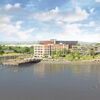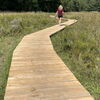In face of resource decline, clam harvesters eye clam farming
The future of clamming could lie in seeding and growing clams in tidal areas, to mitigate declines of the wild resource.
The Times Record reported that Manomet — an environmental research nonprofit in Plymouth, Mass, with an office in Brunswick — recently installed experimental clam farms in Scarborough and Arrowsic, adding to the experimental farm it operates in Georgetown. Manomet and industry and academic partners hope clam-farming can help rehabilitate the harvest, because clam farmers can use nets to keep growing clams safe from predators like crabs.
“If this lets a clammer work, and he just needs to set up nets and things to make it, he’ll do it,” Wendell Cressey, a clammer who plans to farm in Arrowsic, told the newspaper. Manomet’s experimental Georgetown farm yielded enough clams to bring to market for the first time last year.
According to a February 2017 post on Manomet’s website, the Gulf of Maine is heating up faster than 99% of the world’s oceans, and scientists foresee a time when historically lucrative fisheries—like clamming and lobstering —are gone. Soft-shell clam flats are being decimated by a growing population of green crabs. Clamming is Maine’s second most seafood industry, after lobster.
Manomet installed the Georgetown farm in May 2014, in conjunction with Chris Warner, a licensed harvester in Georgetown. The farming method involves seeding the flat and then covering with protective nylon netting.










Comments